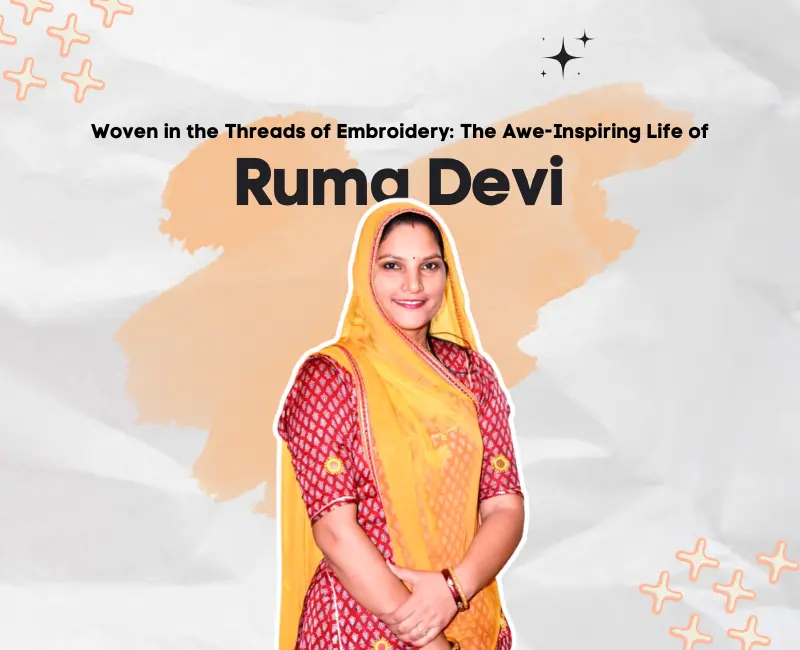Woven in the Threads of Embroidery: The Awe-Inspiring Life of Ruma Devi

Ruma Devi’s story is like the delicate embroidery she’s famous for intricate, colorful, and full of life. Born in a small village in Rajasthan, she grew up in a world where opportunities for women were limited, but dreams were limitless. From a young age, she learned the traditional art of hand embroidery, not just as a skill but as a language through which women could tell their stories. Her journey is a blend of resilience, creativity, and vision. Ruma Devi has faced countless hurdles, from societal expectations to financial challenges, but her determination has never wavered. Through her work, she has given a voice to women who often go unheard, proving that traditional crafts can be a source of pride, identity, and economic independence.
Today, Ruma Devi is recognized nationally and internationally for her contribution to crafts and women’s empowerment. She is not just a master artisan; she is a symbol of what happens when skill meets purpose, and when one woman dares to lift many along with her.
Early Life
Ruma Devi was born in a small village in Rajasthan, where life for girls was often limited to household chores, little education, and early marriage. From a young age, she showed curiosity and determination that set her apart. She was drawn to embroidery, a craft passed down through generations and quickly realized it was more than decoration. Each stitch told a story and gave her a sense of purpose beyond the walls of her home.
Her family faced financial challenges, but Ruma learned patience, resourcefulness, and the value of hard work. She observed the women around her, absorbing not only their techniques but the cultural heritage behind each design. Embroidery became her way of expressing herself and quietly challenging the expectations placed on her.
By her teenage years, Ruma had developed the skills and mindset that would later allow her to empower thousands of women. Her early life was humble and constrained, yet rich with lessons in perseverance, creativity, and the quiet strength of women supporting women. The young girl stitching in her village courtyard was learning the first threads of a story that would inspire countless lives.
Education and How She Got into Embroidery
Ruma Devi’s formal education was limited, as is common in many rural areas where girls often have to leave school early to help with household work. Despite this, she displayed a natural curiosity and eagerness to learn. Much of her early education came from observing the world around her, listening carefully, and learning by doing.
Her introduction to embroidery was not through a classroom but through her family and community. Women in her household taught her the basics, showing her how to handle needles, select threads, and create traditional patterns. At first, she practiced simply imitating them, but she quickly discovered that embroidery gave her a sense of purpose and creativity.
Over time, her learning became self-directed. She experimented with colors, designs, and techniques, often spending long hours perfecting each stitch. The combination of traditional guidance and her own curiosity allowed her to develop a skill that was both authentic and uniquely her own. This early education in craft, though informal, became the foundation for a career that would not only support her but also empower thousands of women across India.
Discovering Purpose Through Craft
In her early twenties, Ruma Devi realized that embroidery could be more than a personal skill, it could be a way to create opportunity and change lives. She began teaching women in her village how to make hand-embroidered pieces, encouraging them to earn a living from the craft. What started as a small gathering of a few women soon grew into a community united by creativity and ambition.
Ruma’s approach was simple but powerful. She combined traditional techniques with new ideas, helping women adapt designs for modern markets without losing the authenticity of their heritage. Beyond skill, she taught confidence and independence. Many of the women she worked with had never left their homes or imagined earning their own income, but under Ruma’s guidance, they discovered both.
This period was transformative for Ruma as well. She saw firsthand how art could empower, inspire, and connect people. Each piece stitched by her growing network of artisans became a story of pride, resilience, and hope. The realization that her craft could transform lives gave her purpose and set her on a path that would expand far beyond her village.
Building a Movement
From her small beginnings, Ruma Devi’s vision grew steadily. What started with a handful of women in her village soon expanded into a network reaching thousands of rural artisans across India. She focused on creating opportunities for women who had talent but lacked confidence or access to markets. Her goal was simple: to empower women through craft while preserving India’s traditional embroidery.
Ruma traveled from village to village, teaching techniques, mentoring women, and providing guidance on creating and selling their work. She emphasized quality, creativity, and pride in the craft, helping artisans understand that their skills had real value. Over time, her initiative transformed into a structured network, enabling women to earn sustainable incomes and gain independence.
Beyond income, Ruma’s work built a sense of community. Women who had once been confined to their homes began to meet, share ideas, and support one another. Each embroidered piece became a symbol of resilience and self-belief. Through her leadership, Ruma showed that traditional art could do more than decorate fabric; it could change lives and uplift entire communities.
Challenges Along the Way
Ruma Devi’s journey was not without obstacles. She faced skepticism from her community, limited resources, and the difficulty of convincing women to step outside traditional roles. Many artisans were hesitant to share their work beyond the village, fearing criticism or failure. Securing materials, connecting with markets, and managing logistics added further challenges.
Financial constraints were constant. Ruma often had to find creative solutions to keep the initiative running, from sourcing affordable materials to organizing training sessions with minimal resources. Social barriers were equally difficult. Convincing families to allow women to participate required patience, persistence, and proof that embroidery could be more than a hobby.
Despite these difficulties, Ruma never gave up. She adapted traditional techniques to suit modern tastes, encouraged innovation in designs, and continuously motivated women to believe in themselves. Each challenge became an opportunity to learn and strengthen the network. Her resilience and vision allowed her to turn obstacles into stepping stones, gradually transforming a small village initiative into a movement that would empower thousands of women across India.
National and International Recognition
Ruma Devi’s work gradually gained attention beyond her village. Her efforts to empower rural women through embroidery were recognized nationally, earning her awards and invitations to showcase her work at major cultural and craft forums. She became a symbol of how traditional skills could be transformed into a source of economic independence and social change.
Internationally, her initiatives have been celebrated for preserving India’s rich craft heritage while creating meaningful livelihoods. Exhibitions and conferences around the world have invited her to speak about her journey and the impact of her network. Documentaries and media coverage have highlighted her role in giving a voice to women who were once invisible in society.
Despite widespread recognition, Ruma remains grounded. She often emphasizes that the real reward lies in the lives she has touched. Seeing women earn independently, gain confidence, and carry forward their skills is far more fulfilling than any accolade. Her story serves as a reminder that true success is measured not only by awards but by the tangible difference one can make in the lives of others.
Empowering Women Through Art
For Ruma Devi, embroidery has always been more than a craft; it is a tool for empowerment. Through her guidance, women who once felt invisible now discover their own strength and creativity. Learning to create intricate designs gives them a sense of pride and accomplishment, while earning from their work brings independence and confidence.
Her network teaches women not just how to stitch but also how to manage their earnings, connect with buyers, and navigate the challenges of running a small business. Many artisans have gone from having no voice or choice in their lives to becoming leaders in their communities. The act of creating together fosters camaraderie, mutual support, and a shared sense of achievement. Each embroidered piece carries a story of resilience, hope, and transformation. Ruma Devi has shown that when women are given skill, guidance, and opportunity, they can redefine their futures. Her work demonstrates that empowerment is not just about financial gain but also about reclaiming identity, building confidence, and realizing one’s potential.
Preserving Cultural Heritage
Ruma Devi’s work goes beyond empowerment; it is also about preserving India’s rich embroidery traditions. In an era dominated by machine-made textiles, she emphasizes the value of hand-crafted art. By training rural women and creating market opportunities, she ensures that centuries-old techniques survive and remain relevant.
Her approach balances tradition and innovation. While artisans learn modern ways to adapt designs for contemporary markets, they retain the authenticity of motifs, patterns, and cultural symbolism. Each piece reflects the heritage of Rajasthan and other regions while telling a story that resonates with today’s buyers.
Through her efforts, younger generations of artisans gain not only skill but also understanding of the cultural context behind each design. This ensures that embroidery remains a living tradition rather than a fading craft. Ruma Devi has successfully turned a domestic skill into both a source of income and a means to preserve cultural identity, showing that heritage and empowerment can go hand in hand.
Impact and Legacy
Ruma Devi’s influence extends far beyond embroidery. She has transformed perceptions about women in rural India, showing that talent, ambition, and determination can flourish even in the most constrained environments. Through her network, tens of thousands of women now earn sustainable incomes, support their families, and gain confidence in themselves.
Her work has inspired other initiatives, NGOs, and government programs aimed at women’s empowerment and handicraft preservation. Rural communities see the benefits not only economically but socially, as women who once stayed confined at home now play active roles in their families and villages. Ruma’s model proves that one person’s vision, combined with perseverance, can ripple across society, creating lasting change.
Beyond measurable impact, her legacy lies in the mindset she has fostered. Women who were once hesitant to step into public spaces now lead, teach, and innovate. Young artisans have role models to look up to, and entire communities have come to value traditional crafts as both a source of pride and livelihood. Ruma Devi’s life shows that change begins with a single stitch and grows into a movement that can reshape lives and culture.
Global Influence and Recognition
Ruma Devi’s impact is not confined to India. She has been invited to international forums, craft fairs, and cultural exhibitions to showcase her work and share her model of women’s empowerment. Her initiatives have drawn attention from global organizations that promote sustainable development, women’s rights, and preservation of traditional arts.
Through media coverage, documentaries, and collaborations, Ruma has helped bring rural Indian craftsmanship to international markets. Her story has sparked interest in handmade arts, sustainable fashion, and social entrepreneurship worldwide. By combining skill, leadership, and vision, she demonstrates that local traditions can have a global influence while creating tangible benefits for communities at home.
Conclusion
Ruma Devi’s life is a testament to the power of skill, vision, and determination. From a young girl learning embroidery in a small Rajasthan village to a leader empowering ten of thousands of women across India, her journey shows what is possible when talent meets purpose. She has turned a traditional craft into a tool for independence, confidence, and cultural preservation, proving that art can do far more than decorate it can transform lives. Through her work, she has inspired a movement, preserved a cultural heritage, and shown that women’s potential knows no bounds. In celebrating Ruma Devi, we celebrate the strength of women, the beauty of tradition, and the transformative power of determination.


